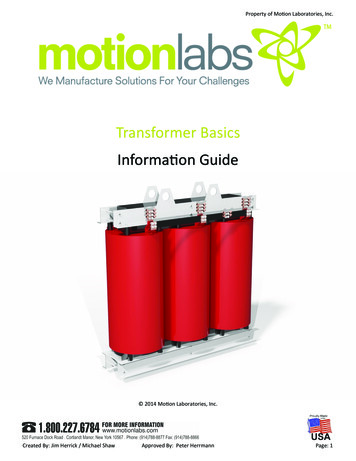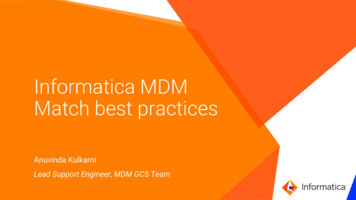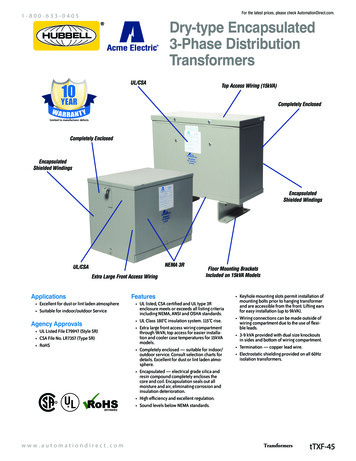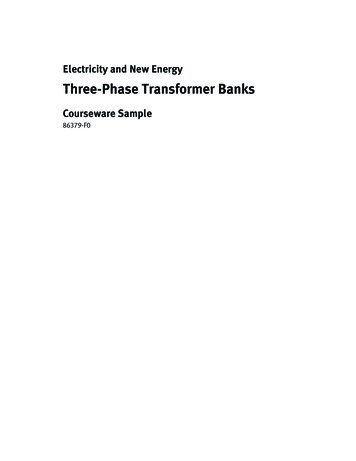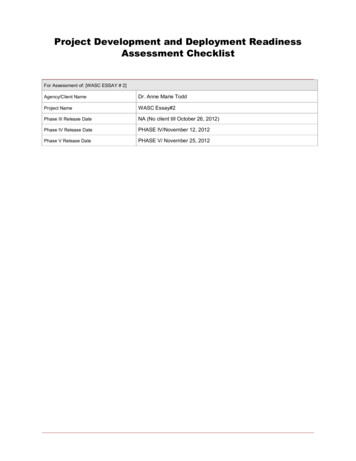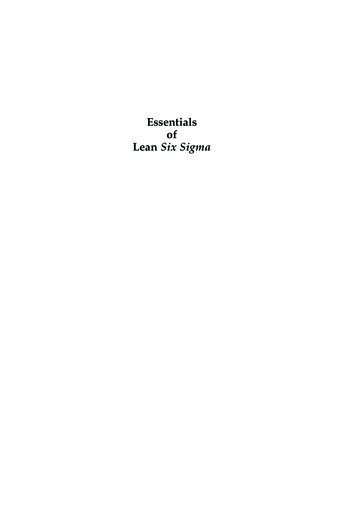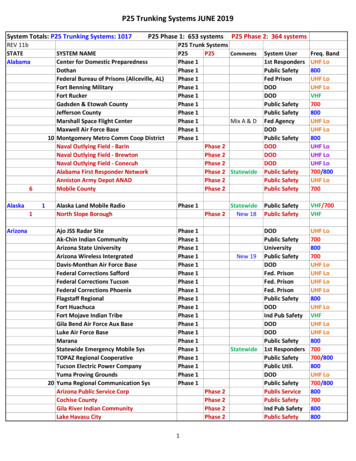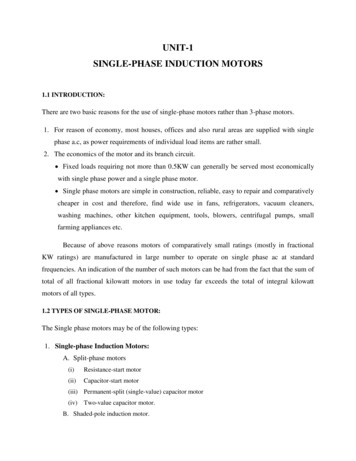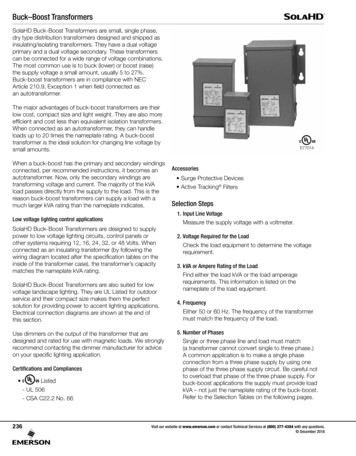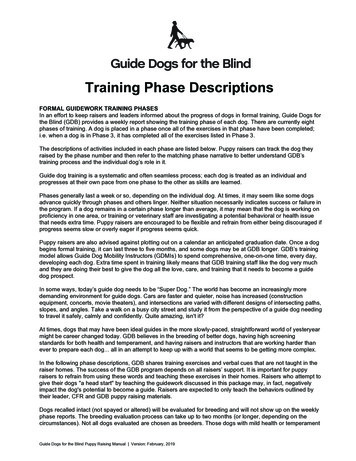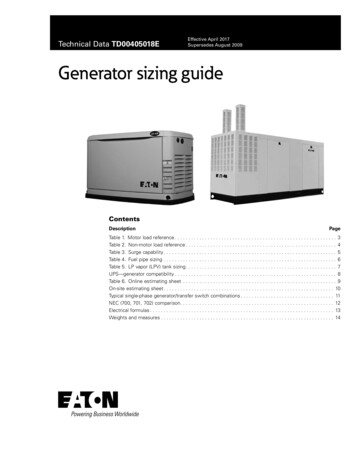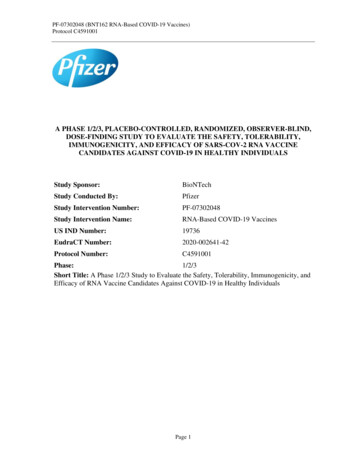
Transcription
PF-07302048 (BNT162 RNA-Based COVID-19 Vaccines)Protocol C4591001A PHASE 1/2/3, PLACEBO-CONTROLLED, RANDOMIZED, OBSERVER-BLIND,DOSE-FINDING STUDY TO EVALUATE THE SAFETY, TOLERABILITY,IMMUNOGENICITY, AND EFFICACY OF SARS-COV-2 RNA VACCINECANDIDATES AGAINST COVID-19 IN HEALTHY INDIVIDUALSStudy Sponsor:BioNTechStudy Conducted By:PfizerStudy Intervention Number:PF-07302048Study Intervention Name:RNA-Based COVID-19 VaccinesUS IND Number:19736EudraCT Number:2020-002641-42Protocol Number:C4591001Phase:1/2/3Short Title: A Phase 1/2/3 Study to Evaluate the Safety, Tolerability, Immunogenicity, andEfficacy of RNA Vaccine Candidates Against COVID-19 in Healthy IndividualsPage 1
PF-07302048 (BNT162 RNA-Based COVID-19 Vaccines)Protocol C4591001TABLE OF CONTENTSLIST OF TABLES .81. PROTOCOL SUMMARY .91.1. Synopsis .91.2. Schema .171.3. Schedule of Activities .181.3.1. Phase 1 .181.3.2. Phase 2/3 .232. INTRODUCTION .262.1. Study Rationale .262.2. Background .262.2.1. Clinical Overview .272.3. Benefit/Risk Assessment .272.3.1. Risk Assessment .292.3.2. Benefit Assessment .312.3.3. Overall Benefit/Risk Conclusion .313. OBJECTIVES, ESTIMANDS, AND ENDPOINTS .313.1. For Phase 1 .313.2. For Phase 2/3 .334. STUDY DESIGN.364.1. Overall Design.364.1.1. Phase 1 .364.1.2. Phase 2/3 .374.2. Scientific Rationale for Study Design .394.3. Justification for Dose .394.4. End of Study Definition .405. STUDY POPULATION .405.1. Inclusion Criteria .405.2. Exclusion Criteria .41Page 2
PF-07302048 (BNT162 RNA-Based COVID-19 Vaccines)Protocol C45910015.3. Lifestyle Considerations .445.3.1. Contraception .445.4. Screen Failures .445.5. Criteria for Temporarily Delaying Enrollment/Randomization/StudyIntervention Administration .446. STUDY INTERVENTION .456.1. Study Intervention(s) Administered .466.1.1. Manufacturing Process .466.1.2. Administration .466.2. Preparation/Handling/Storage/Accountability .476.2.1. Preparation and Dispensing .486.3. Measures to Minimize Bias: Randomization and Blinding.486.3.1. Allocation to Study Intervention .486.3.2. Blinding of Site Personnel .486.3.3. Blinding of the Sponsor .496.3.4. Breaking the Blind .506.4. Study Intervention Compliance .506.5. Concomitant Therapy .506.5.1. Prohibited During the Study .506.5.2. Permitted During the Study .516.6. Dose Modification .516.7. Intervention After the End of the Study .527. DISCONTINUATION OF STUDY INTERVENTION AND PARTICIPANTDISCONTINUATION/WITHDRAWAL .527.1. Discontinuation of Study Intervention .527.2. Participant Discontinuation/Withdrawal From the Study .537.2.1. Withdrawal of Consent .537.3. Lost to Follow-up .548. STUDY ASSESSMENTS AND PROCEDURES .548.1. Efficacy and/or Immunogenicity Assessments .558.1.1. Biological Samples .588.2. Safety Assessments .588.2.1. Clinical Safety Laboratory Assessments (Phase 1 Participants Only) .59Page 3
PF-07302048 (BNT162 RNA-Based COVID-19 Vaccines)Protocol C45910018.2.2. Electronic Diary .598.2.2.1. Grading Scales .608.2.2.2. Local Reactions .608.2.2.3. Systemic Events .618.2.2.4. Fever .628.2.2.5. Antipyretic Medication .628.2.3. Phase 1 Stopping Rules .628.2.4. Surveillance of Events That Could Represent Enhanced COVID-19and Phase 2/3 Stopping Rule .648.2.5. Randomization and Vaccination After a Stopping Rule Is Met .648.2.6. Pregnancy Testing .658.3. Adverse Events and Serious Adverse Events .658.3.1. Time Period and Frequency for Collecting AE and SAE Information .658.3.1.1. Reporting SAEs to Pfizer Safety .668.3.1.2. Recording Nonserious AEs and SAEs on the CRF .668.3.2. Method of Detecting AEs and SAEs .668.3.3. Follow-up of AEs and SAEs.668.3.4. Regulatory Reporting Requirements for SAEs.678.3.5. Exposure During Pregnancy or Breastfeeding, and OccupationalExposure .678.3.5.1. Exposure During Pregnancy .678.3.5.2. Exposure During Breastfeeding .698.3.5.3. Occupational Exposure .698.3.6. Cardiovascular and Death Events .708.3.7. Disease-Related Events and/or Disease-Related Outcomes NotQualifying as AEs or SAEs.708.3.8. Adverse Events of Special Interest .708.3.8.1. Lack of Efficacy .708.3.9. Medical Device Deficiencies .708.3.10. Medication Errors .708.4. Treatment of Overdose .718.5. Pharmacokinetics .728.6. Pharmacodynamics .72Page 4
PF-07302048 (BNT162 RNA-Based COVID-19 Vaccines)Protocol C45910018.7. Genetics .728.8. Biomarkers .728.9. Immunogenicity Assessments .728.10. Health Economics .728.11. Study Procedures .728.11.1. Phase 1 .728.11.1.1. Screening: (0 to 28 Days Before Visit 1) .728.11.1.2. Visit 1 – Vaccination 1: (Day 1) .748.11.1.3. Visit 2 – Next-Day Follow-up Visit (Vaccination 1): (1to 3 Days After Visit 1) .768.11.1.4. Visit 3 – 1-Week Follow-up Visit (Vaccination 1): (6 to8 Days After Visit 1) .788.11.1.5. Visit 4 – Vaccination 2: (19 to 23 Days After Visit 1) .798.11.1.6. Visit 5 – 1-Week Follow-up Visit (Vaccination 2): (6 to8 Days After Visit 4) .818.11.1.7. Visit 6 – 2-Week Follow-up Visit (Vaccination 2): (12 to16 Days After Visit 4) .828.11.1.8. Visit 7 – 1-Month Follow-up Visit: (28 to 35 Days AfterVisit 4) .838.11.1.9. Visit 8 – 6-Month Follow-up Visit: (175 to 189 DaysAfter Visit 4).848.11.1.10. Visit 9 – 12-Month Follow-up Visit: (350 to 378 DaysAfter Visit 4).848.11.1.11. Visit 10 – 24-Month Follow-up Visit: (714 to 742 DaysAfter Visit 4).858.11.2. Phase 2/3 .858.11.2.1. Visit 1 – Vaccination 1: (Day 1) .858.11.2.2. Visit 2 – Vaccination 2: (19 to 23 Days After Visit 1) .888.11.2.3. Visit 3 – 1-Month Follow-up Visit (After Vaccination 2):(28 to 35 Days After Visit 2) .908.11.2.4. Visit 4 – 6-Month Follow-up Visit: (175 to 189 DaysAfter Visit 2).918.11.2.5. Visit 5 – 12-Month Follow-up Visit: (350 to 378 DaysAfter Visit 2).918.11.2.6. Visit 6 – 24-Month Follow-up Visit: (714 to 742 DaysAfter Visit 2).92Page 5
PF-07302048 (BNT162 RNA-Based COVID-19 Vaccines)Protocol C45910018.12. Unscheduled Visit for a Grade 3 or Suspected Grade 4 Reaction .928.13. COVID-19 Surveillance (All Participants) .938.13.1. Potential COVID-19 Illness Visit: (Optimally Within 3 Days AfterPotential COVID-19 Illness Onset) .958.13.2. Potential COVID-19 Convalescent Visit: (28 to 35 Days AfterPotential COVID-19 Illness Visit) .968.14. Communication and Use of Technology .968.15. SARS-CoV-2 NAAT Results From Visits 1 and 2 and Potential COVID-19Illness Visits .979. STATISTICAL CONSIDERATIONS .989.1. Estimands and Statistical Hypotheses .989.1.1. Estimands .989.1.2. Statistical Hypotheses .999.1.2.1. Statistical Hypothesis Evaluation for Efficacy .999.1.2.2. Statistical Hypothesis Evaluation for Immunogenicity .999.2. Sample Size Determination .999.3. Analysis Sets .1019.4. Statistical Analyses .1029.4.1. Immunogenicity Analyses .1029.4.2. Efficacy Analyses .1079.4.3. Safety Analyses .1099.4.4. Other Analyses.1109.5. Interim Analyses .1119.5.1. Analysis Timing.1149.6. Data Monitoring Committee or Other Independent Oversight Committee .11410. SUPPORTING DOCUMENTATION AND OPERATIONALCONSIDERATIONS .11610.1. Appendix 1: Regulatory, Ethical, and Study Oversight Considerations .11610.1.1. Regulatory and Ethical Considerations .11610.1.1.1. Reporting of Safety Issues and Serious Breaches of theProtocol or ICH GCP.11610.1.2. Informed Consent Process .11710.1.3. Data Protection .118Page 6
PF-07302048 (BNT162 RNA-Based COVID-19 Vaccines)Protocol C459100110.1.4. Dissemination of Clinical Study Data .11810.1.5. Data Quality Assurance .11910.1.6. Source Documents .12010.1.7. Study and Site Start and Closure .12110.1.8. Sponsor’s Qualified Medical Personnel .12110.2. Appendix 2: Clinical Laboratory Tests .12310.3. Appendix 3: Adverse Events: Definitions and Procedures for Recording,Evaluating, Follow-up, and Reporting .12510.3.1. Definition of AE .12510.3.2. Definition of SAE .12610.3.3. Recording/Reporting and Follow-up of AEs and/or SAEs.12810.3.4. Reporting of SAEs .13110.4. Appendix 4: Contraceptive Guidance .13210.4.1. Male Participant Reproductive Inclusion Criteria .13210.4.2. Female Participant Reproductive Inclusion Criteria.13210.4.3. Woman of Childbearing Potential .13310.4.4. Contraception Methods .13410.5. Appendix 5: Liver Safety: Suggested Actions and Follow-up Assessments .13610.6. Appendix 6: Abbreviations .13810.7. Appendix 7: Stopping and Alert Rules for Enhanced COVID-19 .14210.8. Appendix 8: Criteria for Allowing Inclusion of Participants With ChronicStable HIV, HCV, or HBV Infection .14511. REFERENCES .146Page 7
PF-07302048 (BNT162 RNA-Based COVID-19 Vaccines)Protocol C4591001LIST OF TABLESTable 1.Local Reaction Grading Scale .60Table 2.Systemic Event Grading Scale.61Table 3.Scale for Fever .62Table 4.Power Analysis for Noninferiority Assessment .100Table 5.Probability of Observing at Least 1 AE by Assumed True EventRates With Different Sample Sizes .101Table 6.Interim Analysis Plan and Boundaries for Efficacy and Futility .112Table 7.Statistical Design Operating Characteristics: Probability of Successor Failure for Interim Analyses.113Table 8.Statistical Design Operating Characteristics: Probability of Successfor Final Analysis and Overall .113Table 9.Laboratory Abnormality Grading Scale .123Table 10.Stopping Rule: Enrollment Is Stopped if the Number of SevereCases in the Vaccine Group Is Greater Than or Equal to thePrespecified Stopping Rule Value (S) .143Table 11.Alert Rule: Further Action Is Taken if the Number of Severe Casesin the Vaccine Group Is Greater Than or Equal to the PrespecifiedAlert Rule Value (A) .144Page 8
PF-07302048 (BNT162 RNA-Based COVID-19 Vaccines)Protocol C45910011. PROTOCOL SUMMARY1.1. SynopsisShort Title: A Phase 1/2/3 Study to Evaluate the Safety, Tolerability, Immunogenicity, andEfficacy of RNA Vaccine Candidates Against COVID-19 in Healthy IndividualsRationaleA pneumonia of unknown cause detected in Wuhan, China, was first reported inDecember 2019. On 08 January 2020, the pathogen causing this outbreak was identified as anovel coronavirus 2019. The outbreak was declared a Public Health Emergency ofInternational Concern on 30 January 2020. On 12 February 2020, the virus was officiallynamed as severe acute respiratory syndrome coronavirus 2 (SARS-CoV-2), and the WHOofficially named the disease caused by SARS-CoV-2 as coronavirus disease 2019(COVID-19). On 11 March 2020, the WHO upgraded the status of the COVID-19 outbreakfrom epidemic to pandemic, which is now spreading globally at high speed.There are currently no licensed vaccines to prevent infection with SARS-CoV-2 orCOVID-19. Given the rapid transmission of COVID-19 and incidence of disease in theUnited States and elsewhere, the rapid development of an effective vaccine is of utmostimportance.BioNTech has developed RNA-based vaccine candidates using a platform approach thatenables the rapid development of vaccines against emerging viral diseases, includingSARS-CoV-2. Each vaccine candidate is based on a platform of nucleoside-modifiedmessenger RNA (modRNA, BNT162b). Each vaccine candidate expresses 1 of 2 antigens:the SARS-CoV-2 full-length, P2 mutant, prefusion spike glycoprotein (P2 S) (version 9) or atrimerized SARS-CoV-2 spike glycoprotein receptor-binding domain (RBD) (version 5).The 2 SARS-CoV-2 vaccine candidates that will be tested in this study are therefore:BNT162b1 (variant RBP020.3): a modRNA encoding the RBD;BNT162b2 (variant RBP020.2): a modRNA encoding P2 S.All candidates are formulated in the same lipid nanoparticle (LNP) composition. This studyis intended to investigate the safety, immunogenicity, and efficacy of these prophylacticBNT162 vaccines against COVID-19.Page 9
PF-07302048 (BNT162 RNA-Based COVID-19 Vaccines)Protocol C4591001Objectives, Estimands, and EndpointsFor Phase 1ObjectivesPrimary:To describe the safety and tolerabilityprofiles of prophylactic BNT162vaccines in healthy adults after 1 or 2dosesSecondary:To describe the immune responseselicited by prophylactic BNT162vaccines in healthy adults after 1 or 2dosesEstimandsEndpointsPrimary:In participants receiving at least 1 doseof study intervention, the percentage ofparticipants reporting: Local reactions for up to 7 daysfollowing each dose Systemic events for up to 7 daysfollowing each dose Adverse events (AEs) fromDose 1 to 1 month after the lastdose Serious AEs (SAEs) from Dose 1to 6 months after the last dosePrimary: Local reactions (pain at theinjection site, redness, andswelling) Systemic events (fever, fatigue,headache, chills, vomiting,diarrhea, new or worsened musclepain, and new or worsened jointpain) AEs SAEsIn addition, the percentage ofHematology and chemistry laboratoryparticipants with:parameters detailed in Section 10.2 Abnormal hematology andchemistry laboratory values 1 and7 days after Dose 1; and 7 daysafter Dose 2 Grading shifts in hematology andchemistry laboratory assessmentsbetween baseline and 1 and 7 daysafter Dose 1; and before Dose 2and 7 days after Dose 2Secondary:Secondary:In participants complying with the keyprotocol criteria (evaluableparticipants) at the following timepoints after receipt of studyintervention:7 and 21 days after Dose 1; 7 and 14days and 1, 6, 12, and 24 months afterDose 2 Geometric mean titers (GMTs) at SARS-CoV-2 neutralizing titerseach time pointGeometric mean fold rise (GMFR)from before vaccination to eachsubsequent time point aftervaccinationProportion of participantsachieving 4-fold rise from beforevaccination to each subsequenttime point after vaccinationPage 10
PF-07302048 (BNT162 RNA-Based COVID-19 Vaccines)Protocol C4591001ObjectivesEstimands Geometric mean concentrations(GMCs) at each time pointGMFR from before vaccination toeach subsequent time point aftervaccinationProportion of participantsachieving 4-fold rise from beforevaccination to each subsequenttime point after vaccinationGeometric mean ratio (GMR),estimated by the ratio of thegeometric mean of SARS-CoV-2neutralizing titers to the geometricmean of binding IgG levels at eachtime pointEndpointsS1-binding IgG levels andRBD-binding IgG levels SARS-CoV-2 neutralizing titersS1-binding IgG levelsRBD-binding IgG levelsFor Phase 2/3ObjectivesaEstimandsPrimary EfficacyTo evaluate the efficacy ofprophylactic BNT162b2 againstconfirmed COVID-19 occurring from7 days after the second dose inparticipants without evidence ofinfection before vaccinationIn participants complying with thekey protocol criteria (evaluableparticipants) at least 7 days afterreceipt of the second dose of studyintervention:100 (1 – IRR) [ratio of activevaccine to placebo]To evaluate the efficacy ofprophylactic BNT162b2 againstconfirmed COVID-19 occurring from7 days after the second dose inparticipants with and withoutevidence of infection beforevaccinationIn participants complying with thekey protocol criteria (evaluableparticipants) at least 7 days afterreceipt of the second dose of studyintervention:100 (1 – IRR) [ratio of activevaccine to placebo]To define the safety profile ofprophylactic BNT162b2 in the first360 participants randomized (Phase 2)In participants receiving at least 1dose of study intervention, thepercentage of participants reporting: Local reactions for up to 7 daysfollowing each dose Systemic events for up to 7 daysfollowing each dose AEs from Dose 1 to 7 days afterthe second dose SAEs from Dose 1 to 7 daysafter the second doseEndpointsCOVID-19 incidence per 1000person-years of follow-up based oncentral laboratory or locallyconfirmed NAAT in participants withno serological or virological evidence(up to 7 days after receipt of thesecond dose) of past SARS-CoV-2infectionCOVID-19 incidence per 1000person-years of follow-up based oncentral laboratory or locallyconfirmed NAATPrimary SafetyPage 11 Local reactions (pain at theinjection site, redness, andswelling)Systemic events (fever, fatigue,headache, chills, vomiting,diarrhea, new or worsenedmuscle pain, and new orworsened joint pain)AEsSAEs
PF-07302048 (BNT162 RNA-Based COVID-19 Vaccines)Protocol C4591001ObjectivesaEstimandsEndpointsTo define the safety profile ofprophylactic BNT162b2 in allparticipants randomized in Phase 2/3In participants receiving at least1 dose of study intervention, thepercentage of participants reporting: Local reactions for up to 7 daysfollowing each dose Systemic events for up to 7 daysfollowing each dose AEs from Dose 1 to 1 monthafter the second dose SAEs from Dose 1 to 6 monthsafter the second dose To define the safety profile ofprophylactic BNT162b2 inparticipants 12 to 15 years of age inPhase 3In participants receiving at least1 dose of study intervention, thepercentage of participants reporting: Local reactions for up to 7 daysfollowing each dose Systemic events for up to 7 daysfollowing each dose AEs from Dose 1 to 1 monthafter the second dose SAEs from Dose 1 to 6 monthsafter the second dose AEsSAEsIn a subset of at least 6000participants:o Local reactions (pain at theinjection site, redness, andswelling)o Systemic events (fever,fatigue, headache, chills,vomiting, diarrhea, new orworsened muscle pain, andnew or worsened joint pain)Local reactions (pain at theinjection site, redness, andswelling)Systemic events (fever, fatigue,headache, chills, vomiting,diarrhea, new or worsenedmuscle pain, and new orworsened joint pain)AEsSAEsSecondary EfficacyTo evaluate the efficacy ofprophylactic BNT162b2 againstconfirmed COVID-19 occurring from14 days after the second dose inparticipants without evidence ofinfection before vaccinationIn participants complying with thekey protocol
A PHASE 1/2/3, PLACEBO-CONTROLLED, RANDOMIZED, OBSERVER-BLIND, DOSE-FINDING STUDY TO EVALUATE THE SAFETY, TOLERABILITY, IMMUNOGENICITY, AND EFFICACY OF SARS-COV-2 RNA VACCINE CANDIDATES AGAINST COVID-19 IN HEALTHY INDIVIDUALS Study Sponsor: BioNTech Study Conducted By: Pfizer Study Intervention Number: PF-07302048
